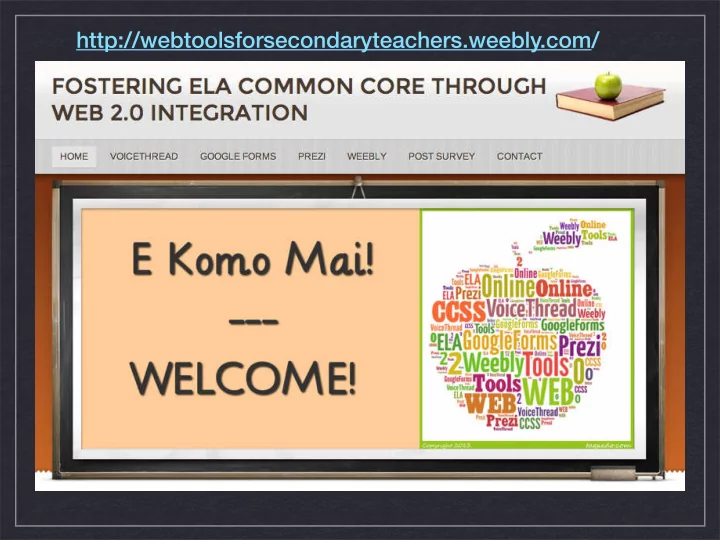

http://webtoolsforsecondaryteachers.weebly.com/
Fostering ELA CCSS through Web 2.0 at the Secondary Level ETEC 690, Spring 2014 University of Hawaii at Manoa
Carly Mounts 3rd year Educational Technology master’s student at the University of Hawaii Manoa 6th year secondary education teacher (social studies & English) *Email: cmounts@hawaii.edu
Presentation Outline Introduction Literature Review Purpose and Objectives of Project Methodology Instructional Strategies, Technologies, Participants Website tour Findings & Discussion Conclusion
INTRODUCTION METHODOLOGY FINDINGS/DISCUSSION CONCLUSION 3 1 2 4 6 5
INTRODUCTION METHODOLOGY FINDINGS/DISCUSSION CONCLUSION HOW DO EDUCATORS MEET THE TECHNOLOGY 3 1 2 NEEDS OF 21ST CENTURY LEARNERS? 4 6 5
INTRODUCTION METHODOLOGY FINDINGS/DISCUSSION CONCLUSION EDUCATORS’ ULTIMATE GOAL = COLLEGE AND CAREER READINESS 7 8
INTRODUCTION METHODOLOGY FINDINGS/DISCUSSION CONCLUSION Literature Review Students have new learner characteristics, influenced by technology that must be addressed in educational environments Prensky, 2001; Skiba & Barton, 2006; Berk, 2010 National Common Core State Standards put technology at the forefront of education National Governors Association Center for Best Practices & Council of Chief of State School Officers, 2010
INTRODUCTION METHODOLOGY FINDINGS/DISCUSSION CONCLUSION Literature Review Shift from teacher-centered to student-centered learning environments through technology integration Hargadon, 2009; U.S. Department of Education, Office of Educational Technology, 2010 Lack of knowledge and experience with basic web tools by teachers and students U.S. Department of Education, Office of Educational Technology, 2010
INTRODUCTION METHODOLOGY FINDINGS/DISCUSSION CONCLUSION Literature Review Lack of professional development to assist teachers in technology integration U.S. Department of Education, National Center for Education Statistics, Fast Response Survey System (FRSS), 2009 WEB 2.0? WEB 2.0?
What Web 2.0 tools would you recommend for secondary educational environments? TYPE RESPONSE IN THE WHITE BOX BELOW OR IN THE CHAT BOX, PLEASE!
INTRODUCTION METHODOLOGY FINDINGS/DISCUSSION CONCLUSION Purpose of Project Develop a web-based learning module to be evaluated on content and design Educate secondary teachers about specific Web 2.0 tools VoiceThread, Google Forms, Prezi, and Weebly Connect each tool to a specific English Language Arts Common Core State Standard (ELA CCSS) sample lesson plans and activities
INTRODUCTION METHODOLOGY FINDINGS/DISCUSSION CONCLUSION Purpose of Project Develop a web-based learning module to be evaluated on content and design Educate secondary teachers about specific Web 2.0 tools VoiceThread, Google Forms, Prezi, and Weebly Connect each tool to a specific English Language Arts Common Core State Standard (ELA CCSS) sample lesson plans and activities
INTRODUCTION METHODOLOGY FINDINGS/DISCUSSION CONCLUSION Purpose of Project Develop a web-based learning module to be evaluated on content and design Educate secondary teachers about specific Web 2.0 tools VoiceThread, Google Forms, Prezi, and Weebly Connect each tool to a specific English Language Arts Common Core State Standard (ELA CCSS) sample lesson plans and activities
INTRODUCTION METHODOLOGY FINDINGS/DISCUSSION CONCLUSION Objectives of Project Improve secondary teachers’ attitude and experience with Web 2.0 Provide a resource for teachers’ future use Emphasize the shared responsibility of developing students’ literacy and technology skills http://webtoolsforsecondaryteachers.weebly.com/
INTRODUCTION METHODOLOGY FINDINGS/DISCUSSION CONCLUSION John Keller’s ARCS MODEL of Motivational Design Attention user friendly language multi-media visuals self-paced with continuous access to site Relevance simple and useful Web 2.0 tools relevant and personal activities to familiarize oneself Cross-curricular lesson examples with specified ELA CCSS access to additional resources
INTRODUCTION METHODOLOGY FINDINGS/DISCUSSION CONCLUSION John Keller’s ARCS MODEL of Motivational Design Confidence informed learners of purpose of project navigational directions explained on homepage Learner objectives for each tool Engaging and meaningful activity and lesson examples Satisfaction Learner guidance provided by examples Simple and consistent design of each page Continued access to website and additional resources
INTRODUCTION METHODOLOGY FINDINGS/DISCUSSION CONCLUSION Technologies Weebly free online web-hosting site drag and drop builder unlimited pages within personalized site Google Forms pre and post surveys collect data ScreenR video tutorials
INTRODUCTION METHODOLOGY FINDINGS/DISCUSSION CONCLUSION Website Tour- Homepage http://webtoolsforsecondaryteachers.weebly.com/
INTRODUCTION METHODOLOGY FINDINGS/DISCUSSION CONCLUSION Website Tour- Homepage
INTRODUCTION METHODOLOGY FINDINGS/DISCUSSION CONCLUSION Website Tour- Homepage
INTRODUCTION METHODOLOGY FINDINGS/DISCUSSION CONCLUSION Website Tour- VoiceThread
INTRODUCTION METHODOLOGY FINDINGS/DISCUSSION CONCLUSION Website Tour- VoiceThread
INTRODUCTION METHODOLOGY FINDINGS/DISCUSSION CONCLUSION Website Tour- VoiceThread
INTRODUCTION METHODOLOGY FINDINGS/DISCUSSION CONCLUSION Website Tour- VoiceThread
INTRODUCTION METHODOLOGY FINDINGS/DISCUSSION CONCLUSION Website Tour- VoiceThread
INTRODUCTION METHODOLOGY FINDINGS/DISCUSSION CONCLUSION Website Tour- VoiceThread
INTRODUCTION METHODOLOGY FINDINGS/DISCUSSION CONCLUSION Website Tour- VoiceThread
INTRODUCTION METHODOLOGY FINDINGS/DISCUSSION CONCLUSION Website Tour- Post-Survey
INTRODUCTION METHODOLOGY FINDINGS/DISCUSSION CONCLUSION Participants recruited through personal emails 8 total- 5 male, 3 female, age range 20s to 60s All from same high school on Oahu range of 2-25+ years of teaching varying in content areas and grade level (English, social studies, science, foreign language) basic knowledge of Web 2.0 interested in technology integration
INTRODUCTION METHODOLOGY FINDINGS/DISCUSSION CONCLUSION Pre-Survey Findings- Background Knowledge 8/8 had some type of Web 2.0 account 7/8 were somewhat familiar with Web 2.0 6/8 only used Web 2.0 for personal/social reasons
INTRODUCTION METHODOLOGY FINDINGS/DISCUSSION CONCLUSION Pre-Survey Findings- Current Use
INTRODUCTION METHODOLOGY FINDINGS/DISCUSSION CONCLUSION Pre-Survey Findings- Current Use
INTRODUCTION METHODOLOGY FINDINGS/DISCUSSION CONCLUSION Post-Survey Findings- Module Content
INTRODUCTION METHODOLOGY FINDINGS/DISCUSSION CONCLUSION Post-Survey Findings- Module Content
INTRODUCTION METHODOLOGY FINDINGS/DISCUSSION CONCLUSION Post-Survey Findings- Module Design
INTRODUCTION METHODOLOGY FINDINGS/DISCUSSION CONCLUSION Post-Survey Findings- Module Design
INTRODUCTION METHODOLOGY FINDINGS/DISCUSSION CONCLUSION Discussion- Comparing Attitudes
INTRODUCTION METHODOLOGY FINDINGS/DISCUSSION CONCLUSION Conclusion- Suggestions “Make lessons related to actual student/teacher assignments” “Hard time getting through content” “Links to additional resources would have been helpful”
Recommend
More recommend